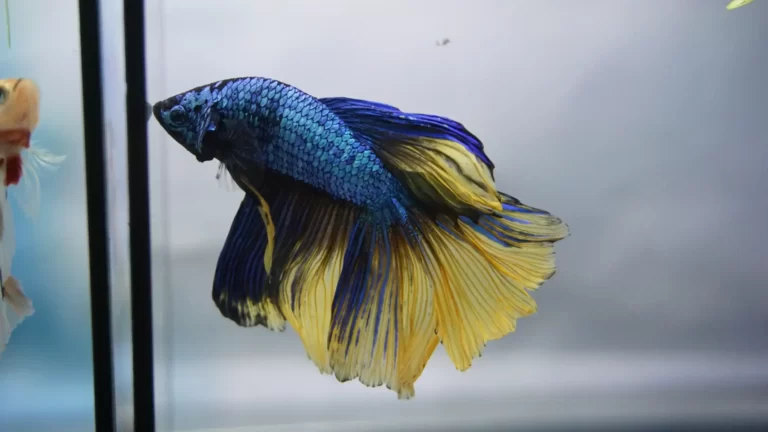Film on Top of Water in Betta Fish Tank: Understanding and Solutions
We plunge into the enigmatic world of Betta fish tanks, specifically addressing the perplexing white film that occasionally graces the water’s surface. Whether you’re a proud Betta parent or embarking on an aquatic journey, this article is your guide to understanding its origins, identification, and bidding it adieu. Let’s transform those Betta bowls into gleaming showcases of aquatic splendor!
Imagine your meticulously arranged Betta fish tank – an oasis of tranquility. Suddenly, an unfamiliar white film emerges on the water’s surface. Rest assured, there’s no cause for alarm. This common occurrence, especially in setups sans filters like Betta bowls, is known as a “bacterial bloom.” It’s a telltale sign of microorganisms reveling in your aquatic realm.

Film on Top of Water in Betta Fish Tank: What Causes It?
You might wonder why Betta bowls seem to be the hotspot for this white film. Well, the answer is simple – still water provides the ideal environment for water bacteria to multiply until they become visible. This doesn’t mean it’s an exclusive Betta party; even established aquariums can experience this phenomenon. Here’s a bit more on the details:
Bacterial Bloom
This is the main culprit behind the white film. Bacteria love still water, and when conditions are right, they proliferate, leading to the noticeable film.
Filter-Free Zones
Betta bowls, lacking the filtration systems that larger tanks possess, are more prone to bacterial blooms. Betta fish tanks with filters have a better shot at keeping these issues at bay.
The Impact of Bacterial Bloom on Your Betta Tank
Now, you might be thinking, “So, what’s the big deal with this film? It’s just a bit of white stuff on the water, right?” Well, it’s a bit more serious than that. Bacterial blooms can negatively impact your Betta fish and the overall tank environment:
Fish Stress:
The presence of the white film can stress out your Betta buddies. We all know that stress isn’t good for anyone, and it’s no different for fish.
Oxygen Depletion:
Bacterial blooms can lead to reduced oxygen levels in the tank, making it harder for your fish to breathe comfortably.
Water Quality
The overall quality of your tank’s water can take a hit. Bacterial blooms can throw off the balance, and if left unchecked, it could lead to more severe water issues.
How to Identify the White Film on Your Betta Fish Tank Water
Spotting the white film isn’t rocket science, but it’s essential to know what you’re dealing with. It’s relatively easy to recognize:
- Distinct Appearance: The white film has a unique look and texture. It’s not like other substances that might find their way into your tank.
- Stillness Matters: The film tends to appear in areas with very little water movement. It’s like they’re throwing a party in the calm spots of your tank!
Preventive Measures for Betta Fish Tanks
An ounce of prevention is worth a pound of cure, they say! To keep that pesky white film from showing up uninvited, there are a few key steps you can take:
Regular Water Changes: Changing a portion of the water in your Betta fish tank helps refresh the environment and reduces the likelihood of bacterial blooms.
Aquarium Filters: If your Betta fish tank doesn’t have a filter, it might be time to consider getting one. Filters help maintain water circulation, keeping those bacteria from throwing a party.
Water Circulation: Even with a filter, make sure your tank has good water circulation. It’s like a breath of fresh air for your underwater buddies.
How to Get Rid of the White Film
Okay, let’s say the film has already crashed your Betta’s party. Fear not! There are effective ways to bid farewell to this unwanted guest:
Natural Solutions: Mother Nature has your back. Try introducing floating plants to your tank or improving tank aeration. These natural methods can help restore balance.
Chemical Solutions: If you’re looking for a quicker fix, consider using protein skimmers or water conditioners. Just be sure to follow the instructions carefully.
Cleaning and Maintaining Betta Bowls
If you’ve got a Betta bowl, you know it’s a bit different from the regular tanks. Here’s how you can keep your Betta bowl in tip-top shape:
Betta bowls need more frequent cleaning. Aim for weekly water changes and thorough cleaning of the bowl to prevent any buildup.
Keep an eye on the water temperature. Betta fish prefer a toasty environment, but extremes can stress them out.
Common Myths and Misconceptions
Ah, the land of aquarium myths – a place where misinformation spreads faster than vampire rumors. Let’s bust a few common myths about the white film:
- Myth: Only Dirty Tanks Get the Film: Nope, even the cleanest tanks can have it, especially if they lack filters.
- Myth: The Film Always Harms Fish: While it’s not great for fish health, it’s not always harmful. The film’s presence is a sign that something’s off in the tank.
Understanding Bacterial Bloom in Established Aquariums
Wait a minute, isn’t bacterial bloom only for Betta bowls? Not quite! Even established aquariums can experience this. Let’s explore why:
- Changing Conditions: Sometimes, changes in water conditions, like a sudden increase in nutrients, can trigger a bacterial bloom.
- Temporary Issue: In established tanks, the bloom might be a temporary hiccup, but it’s essential to address it to maintain a healthy aquatic environment.
Balancing Act: Beneficial Bacteria vs. Harmful Bacteria
Beneficial Bacteria: The Nitrogen Cycle Guardians
Think of beneficial bacteria as the nitrogen cycle superheroes. They’re your tank’s very own cleaning crew, working tirelessly behind the scenes to keep ammonia and nitrites in check. Here’s how they do it:
- Ammonia Warriors: Fish, as cute as they are, release ammonia into the tank through their waste. Ammonia is toxic to fish, but fear not, for our beneficial bacteria swoop in! They convert ammonia into nitrites, which, while still harmful, are a step down from the toxic ammonia.
- Nitrite Ninjas: Once the beneficial bacteria tackle ammonia, they call in the nitrite ninjas. These little warriors transform nitrites into nitrates, which are much less harmful to fish. In moderate amounts, nitrates are usually safe for your aquatic pals.
So, in a nutshell, beneficial bacteria are like the sanitation crew of your tank, ensuring that the harmful stuff is broken down into less harmful substances. This is why a well-established tank with a healthy colony of these bacteria is essential for maintaining water quality and the overall health of your fish.
Read More: Why Is My Betta Fish Twitching?
Harmful Bacteria: The Tank Troublemakers
Now, let’s talk about the less friendly bacteria – the troublemakers. These guys can cause quite a stir in your tank, leading to diseases, water quality issues, and general chaos. Here’s what you need to know:
Disease Carriers:
Some harmful bacteria can be carriers of diseases that affect fish. When they multiply, they can introduce infections to your tank, leading to sick fish and potential outbreaks.
Water Quality Woes:
Too much of the wrong kind of bacteria can throw off the delicate balance in your tank. It can lead to increased ammonia and nitrites, putting stress on your fish and compromising water quality.
Biological Imbalance:
An overgrowth of harmful bacteria can disrupt the natural balance of your tank’s ecosystem. This can impact the growth of plants, the health of other beneficial organisms, and the overall stability of the aquatic environment.
So, you see, it’s all about maintaining the right balance. Beneficial bacteria keep things in check, while harmful bacteria, if allowed to run wild, can wreak havoc in your tank. It’s like having a neighborhood watch – the good guys ensure everyone plays nice, while the troublemakers are kept in check.
Read More: What Fish Can Live with Betta Males: Finding the Perfect Tankmates
Key Takeaways for Maintaining a Healthy Betta Fish Tank
Now that we’ve covered the ins and outs of the white film, let’s summarize the key takeaways:
Prevention is Key: Regular water changes, filters, and good water circulation are your best friends in the fight against the white film.
Natural vs. Chemical Solutions: Choose the approach that aligns with your tank’s needs and your preferences.
Betta Bowl Special Care: Betta bowls require more attention due to their size and lack of filters.
Myths Debunked: Don’t believe everything you hear – the white film isn’t always a disaster.
Bacteria Balance: Beneficial bacteria keep your tank healthy, but watch out for harmful ones.
Frequently Asked Questions [FAQs]
Let’s tackle some of the most common questions about the white film:
What causes the white film on my Betta fish tank water?
It’s a bacterial bloom caused by, well, bacteria having a party.
Can the white film harm my Betta fish?
It can stress them out and affect water quality, so it’s best to address it.
Do I need a filter for my Betta fish tank?
Filters are recommended, especially for preventing bacterial blooms.
How often should I change the water in my Betta bowl?
Aim for weekly water changes to keep the environment fresh.
Are chemical solutions safe for my Betta fish?
When used correctly, they can be effective and safe for your fish.
Conclusion:
And there you have it, a deep dive into the world of that mysterious white film in Betta fish tanks. Remember, being a Betta parent comes with its share of responsibilities, but the rewards are worth it. By staying informed, following preventive measures, and addressing issues promptly, you can provide a healthy and happy home for your finned friends. So, keep those tanks sparkling and those Betta buddies thriving!
Related Posts:


![Is Duckweed Good for Bettas? [Explain]](https://aquariumwiz.com/wp-content/uploads/2023/07/Is-Duckweed-Good-for-Bettas-768x432.webp)


